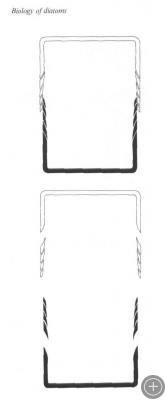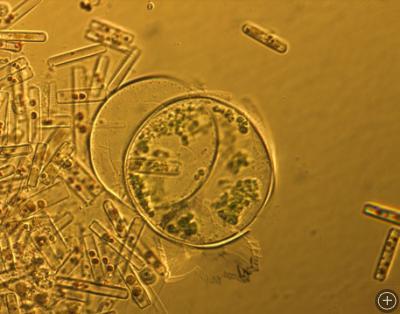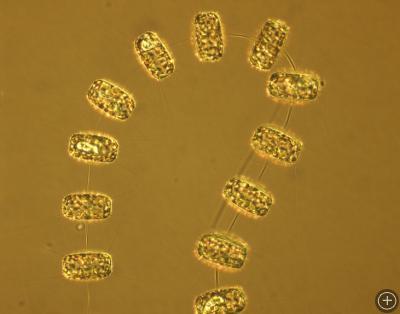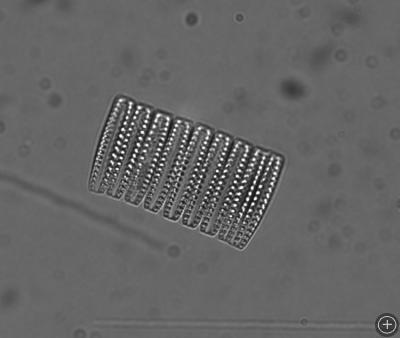All Kinds of Diatoms
March 10th, 2009
ABOARD THE RVIB N. B. PALMER, ON THE SOUTHERN OCEAN– After 4 days in transit we arrived at Clarence Island near the South Shetlands. It is too windy to test our new instruments here. So we turn northeast and after 8 more hours we arrive at the C18A iceberg. This large iceberg was located by satellite images. C18A originated from the Ross Sea Ice Shelf half a continent away. Since 2003 it has traveled hundreds of miles around Antarctica. It entered the Weddell Sea 2 years ago, and it is now on its way north.
At Clarence Island we saw the first phytoplankton bloom of our cruise. Chaetoceros neglectus was the most abundant species. Diatoms are unicellular plants with a silica cell wall that come in many different geometric forms, thickness and sometimes with appendages. The wall has two units called valves that fit together like two halves of a pillbox, the smaller lower valve fitting inside the larger one.

Diatom’s cell wall has 2 halves that fit together like a box. Drawing from Round, Crawford and Mann, The Diatoms, Cambridge University Press, 1980.
Some are round, like in Thalassiosira sp. or Coscinodiscus sp. Others are elongated, like Fragilariopsis sp. Each cell can be seen from the top or the sides, making it sometimes difficult to recognize them. There are lightly silicified species, hard to see at the microscope, like Chaetoceros neglectus. The thickly silicified species are thick, brilliant and easily seen. Many species either central or pennate form chains that look like a necklace, or sometimes a ribbon, with each cell looking like a bead or a scale.
Why the diversity of form? Diatoms need to float in the ocean to live close to the surface, where there is light. Inside the cell there is a vacuole (looking almost like a balloon) where they can store chemicals that help them float. Increasing their wall surface also helps in flotation, thus the formation of chains. All plants survive if the grazers do not decimate them. Being large, as in forming part of a long chain, or having spines help them also to avoid grazing. Diatoms are the preferred food of the Antarctic krill, a common crustacean in these waters, and only the very large species can avoid being eaten.
I am sure we will keep seeing many different diatoms in this cruise and we will be taking pictures of them to share. As it is autumn here, many species are starting to become scarce, present special forms, or spores that help them spend the long winter. We are especially interested in seeing if some forms prefer to live close to the iceberg or if they are somehow concentrating a distance way, affected by melting ice.















I am a diatom taxonomist and am interested in studying diatoms in the gut contents of Holothuria from Ross sea and Weddell Sea areas and comparing them with the diatoms present in water column. I would be very thankful to if you could kindly collect some materials. The diatoms images are excellent and it reminds me of my trip int eh Weddell Sea during 1988 winter cruise as part of AMERIEZ-1988 projects.
Have a safe and productive trip.
Prasad, FSU
Lovely photos, Maria. I know next to nothing about diatoms but like them from a “gee whiz” point of view.
[referred here from the comments in this post of Steffi's, in case you were wondering]
Hello Mam,
I am phytoplankton ecologist and I am interested in diatoms of Southern Ocean. I collected samples from the vicinity of floating icebergs in coastal Antarctic region in Indian Sector of Southern Ocean onboard Akademik Boris Petrov, March 2009. I have got some interesting results after correlating phytoplankton data with physical and chemical parameters. In physical parameters, I have used SST, SSS and wind speed while in Chemical parameters I have used Macro-nutrients, TOC, TCO2, pH and pCO2.
Earlier Smith et al., 2007, Swarzch & Schodlok, 2009 have described possible impacts of icebergs on phytoplankton distribution and abundance from Weddell Sea.
I find your one paper on glacial melt water dynamics of Antarctic Peninsula, PNAS, 2002 very useful.
I would like to discuss my results with you for your constructive comments and suggestions.
Take care and have a nice time
Sunil Kumar Shukla, NCAOR, India
Dear Mrs. Maria Vernet,
Firstly, I have appreciated all kind of information about Antarctic phytoplankton as seen in your personal web page.
I am also a phytoplankton ecologist and up to 2011 I will be studying the phytoplankton community from some places near the South Shetlands, as my PhD Thesis at a Brazilian university (FURG).
So, I have been identified some species like yours and further I will try to obtain some biovolume and biomass features from those plankters.
I would be grateful if we could talk to each other on some scientific doubts. Just thank for sharing your impressions and comments. Good photos!
FURG, Rio Grande do Sul, Brazil
Dear Ms Maria Vernet,
I’m working on diatoms on Moroccan atlantic coast (North africa), O need help, I would be grateful if you get a look on my pictures and confirm my identification,
Thank’s for all the informations
with best redards
Btissam from Morocco